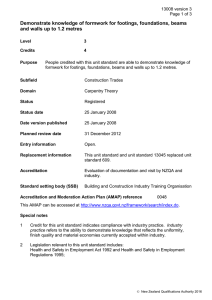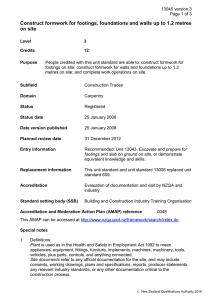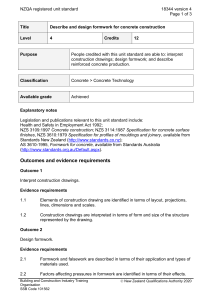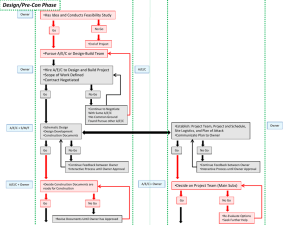FORMWORKS
advertisement
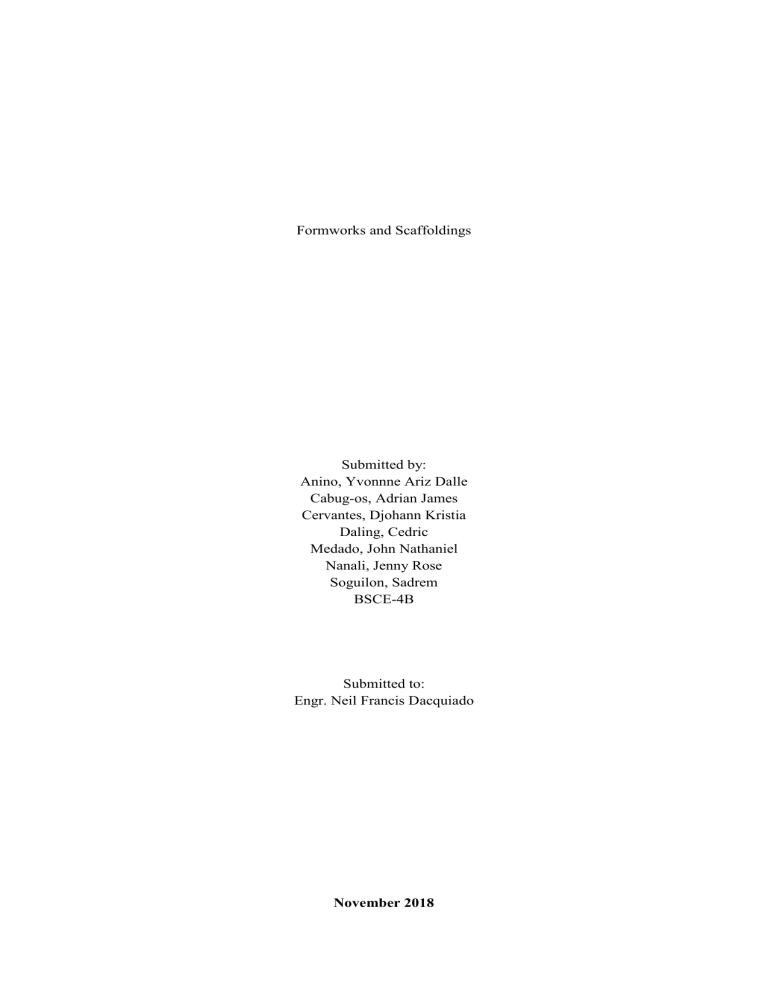
Formworks and Scaffoldings Submitted by: Anino, Yvonnne Ariz Dalle Cabug-os, Adrian James Cervantes, Djohann Kristia Daling, Cedric Medado, John Nathaniel Nanali, Jenny Rose Soguilon, Sadrem BSCE-4B Submitted to: Engr. Neil Francis Dacquiado November 2018 FORMWORKS Introduction Formwork is a mold or open box, like container into which fresh concrete is poured and compacted. When the concrete is set, the formwork is removed and a solid mass is produced in the shape of the inner face of the formwork. The construction of formwork takes time and involves expenditure up to 20 to 25% of the cost of the structure or even more. Design of these temporary structures are made to economic expenditure. Falsework is the necessary support system that holds the formwork in the correct position. The operation of removing the formwork is known as stripping. Stripped formwork can be reused. Reusable forms are known as panel forms. Non-usable are called stationary forms. Formwork for the concrete structures should be: 1. Strong enough to resist the pressure or the weight of the fresh concrete plus any constructional live loads. 2. Rigid enough to retain the shape without undue deformation. 3. Economical in terms of the total cost of the forms and the concrete surface finishing when required. 4. Sufficient watertight to avoid leakage at the joints. Formwork Materials Formwork materials can be classified as: 1. Timber - disadvantage with timber formwork is that it will warp, swell and shrink. Application of water impermeable cost to the surface of wood mitigates these defects a) Lumber - commonly available material and has excellent strength, weight and cost factor. b) Plywood - manufactured wood product consisting a number of veneer sheets, or plies. The use of plywood in concrete forming for form facing has improved the quality of finished concrete. The relative large sheets of plywood have reduced the cost of building and at the same time have provided smooth surfaces. Plywood can be grouped as: Exterior - used for formworks. Adhesive used to bond the piles in manufacturing of exterior plywood is watertight and gives maximum number of reuses Interior 2. Metals - steel forms are largely used in large projects or in situation where large number reuses of the shuttering is possible. This type of shuttering is considered most suitable for circular or curved structures. The initial cost of metal formwork is more than timber formwork but the number of reuses of metal formwork is higher than that of timber. In long run it can be economical. In heavy construction works, metal formwork may require a lifting mechanism to handle the formwork panels or props. Steel sheet formwork has the problem of rusting also. To avoid rusting, in every use, the surfaces should be oiled with an appropriate releasing agent. Steel, aluminum or magnesium are the most widely used metals. 3. Plastics - they have impervious surfaces that usually create a smooth fınish to the concrete. It is lighter but less durable than metal formwork. Plastic formwork could be reinforced or unreinforced. Reinforced plastics are specially produced for a specific formwork type. It is reinforced by glass fibers. Un-reinforced plastics are produced in sheet form with smooth or textured surfaces. Steel forms compared with timber formwork: 1. Steel forms are stronger, durable and have longer life than timber formwork and their reuses are more in number. 2. Steel forms can be installed and dismantled with greater ease and speed. 3. The quality of exposed concrete surface by using steel forms is good and such surfaces need no further treatment. 4. Steel formwork does not absorb moisture from concrete. 5. Steel formwork does not shrink or warp. Advantages of Plastic Formwork: It can be used number of times. It is non-absorbent. Smooth finish surface obtained. No shrinkage of formwork occur. Easy to use. Its volume is less. Its strength is more. Formwork Types Steel Formwork - it is made of angle sheets, angle iron and tee iron. Wooden Formwork - consists of props, planks battens, ledgers and sheeting. Formwork Detail for Different Structural Members 1. Column Formwork - made usually with either timber or metal panels. The principle is to create an enclosed box with frames at the exact size of the column and fix it tightly on the kicker left from base or at the last stage of column concreting. It is held in position by steel column clamps or bolted yokes and supported by timber studs or props. It consists of side and end plunks, yoke, nut and bolts. Two end and two side planks are joined together by yokes and bolts. 2. Beam Formwork - it consists of open through section and because it is not closed at the top requires more supporting framework to restrain the sides. The supports need to be maintained to the soffit and also provide lateral support to the sides. In timber this is done by the use of a head tree across the top of a vertical member. Metal panels are used with corner pieces Slab and Beam formwork consists of sole plate, wedges, props, head tree, planks, batten, and ledgers. 3. Slab Formwork - floors require a large area of formwork to be provided usually from beam to beam. Timber and metal props can be used for vertical supports. Adjustable props need for levelling purposes. Timber floor formwork consists of timber boards or plywood sheets supported on a framework and resting on a series of timber joists. Metal panels can be used and bolted or clipped together and held in place by a system of metal beams or a tabular scaffold system. Slab form work rests on battens and joists. 4. Wall Formwork - simpler than for other concrete units as the actual forces against it are less, most of the load being carried vertically downwards. It consists of timber sheeting, vertical posts, horizontal members, rackers, stakes, and wedges. After completing one side of formwork reinforcement is provided at the place then the second side formwork. 5. Foundation Formworks a) Wall Foundations - consists of plywood sheeting and struts. b) Column Foundations - consists of side supports, side planks and cleats. 6. Stair Formworks - must support the weight of concrete, weight of the throat of the stair and the steps. Some of the force is transmitted sideways because of the slope of the stair. All formwork must be well tied together to prevent side-way movement. It consists of vertical and incline posts, inclined members, wooden planks or sheeting, stringer, and riser planks. Period of Removal of Formwork The time to be allowed before formwork can be removed naturally depends on many factors, such as: 1. The type of concrete mix used (type of cement) - Rapid hardening cement mix requires less time, whereas high water cement ratio needs longer time for striking the formwork. 2. The type of structural member being cast - Soffit of beams and slabs or sides of beams or columns require different time. 3. Temperature - High temperature can cause rapid curing of concrete and formwork can be struck in shorter time than low temperature weather. Structural Member Walls, columns and vertical sides of beams Slabs (props left under) Beam soffits (props left under) Removal of props to slabs (a) For slabs spanning up to 4.5 m (b) For slabs spanning over 4.5 m Removal of props to beams and arches (a) Spanning up to 6 m (b) Spanning over 6 m Period of Time 1 to 2 days 3 days 7 days 7 days 14 days 14 days 21 days Formwork Failures Formwork failures are the cause of many accidents and failures that occur during concrete construction which usually happen when fresh concrete is placed. Generally some unexpected event causes one member to fail, then others become overloaded or misaligned and the entire formwork structure collapses. It is caused by: Inadequate control of concrete placement and bracing Vibration Unstable soil under mudsills, shoring not plumb Lack of attention to formwork details SCAFFOLDING Introduction The method of construction of scaffolds is scaffolding. Scaffolding is the temporary structure to support the original structure as well as workmen used it as a platform to carry on the construction works. Types of scaffolding varies with the type of construction work. Scaffolding is made up of timber or steel. It should be stable and strong to support workmen and other construction material placed on it. Types of scaffolding commonly used in construction works: 1. Supported scaffolding - if elevation is required, then this is the most commonly used scaffolding type. It is considered the easiest and safest form of scaffolding to use. It is the most cost-effective type of scaffolding to use. 2. Suspended scaffolding - this type of scaffolding is usually suspended from a tall construct or roof. It is used when constructing a base is difficult or impossible. It is often used when workers need access to upper levels where building from the ground is impractical. It is often seen when repairs are needed for upper levels too. 3. Rolling scaffolding - This type of scaffolding is similar to supported scaffolding, but there are caster wheels on the base that allow the scaffolding to be moved without the need for it to be deconstructed or added to. The wheels are locked when the scaffolding has been moved so that the construction staff may start work 4. Aerial lifts - a means of cable transport in which cabins, cars, gondolas or open chairs are hauled above the ground by means of one or more cables. 5. Single scaffolding - also called scaffold or staging, is a temporary structure used to support a work crew and materials to aid in the construction, maintenance and repair of buildings, bridges and all other manmade structures. 6. Double scaffolding - a scaffold supported from the base by a double row of uprights, independent of support from the walls and constructed of uprights, ledgers, horizontal platform bearers, and diagonal bracing. 7. Cantilever scaffolding - is a separate scaffold constructed to angle out from a building. This is used when obstacles on the ground or narrow pathways prevent basing the scaffolding on the ground. 8. Trestle scaffolding - a framework in the form of a horizontal member supported at each end by a pair of splayed legs, used to carry scaffold boards, a table top, etc. It is also a braced structural tower - like framework of timber, metal, or reinforced concrete that is used to support a bridge or ropeway 9. Steel scaffolding - any of various alloys based on iron containing carbon (usually 0.1-1.7%) and often small quantities of other elements such as phosphorus, sulfur, manganese, chromium, and nickel. Steels exhibit a variety of properties, such as strength, machinability, malleability, etc., depending on their composition and the way they have been treated. 10. Patented scaffolding - are made up of steel but these are equipped with special couplings and frames etc., these are ready made scaffoldings which are available in the market. In this type of scaffolding working platform is arranged on brackets which can be adjustable to our required level. Various Part of Scaffolds Standard - vertical scaffold tube that bears the weight of the scaffold Ledger - a lengthwise horizontal scaffold tube that extends from standard to standard, that supports the transoms and that forms a tie between the standards Transom - a horizontal transverse scaffold member, that may support platforms units, and which is supported by at least two ledgers or connected directly to at least two standards Coupler - a component or device used to fix scaffold tubes together Plank - an individual timber board or fabricated component that serves as a flooring member of a platform Handrail - a barrier consisting of pipes erected to prevent workers from falling of an elevated work area Toe Board - a barrier min 150 mm height to prevent slip/fall of material from platform. Mudsill (Sole Plate) - it is a wooden plate that is used to distribute the scaffolding load over a suitable ground area. Midrail Base Plate - carries the weight of scaffold, prevent sinking of standards and overturning. Diagonal - Bracing, Access Ladder Scaffold Fittings Scaffold Fittings play a critical role in the construction of various types of scaffolds. Because of their importance, the scaffold fittings are made of durable materials like metal tubes or steel pipes. These fittings offer various uses, but the two most common uses are – construction workers use them to access hard-to-reach spaces in the tower and used when coping with weight adjustments is needed. A number of scaffolding fittings are assembled together to form a structure that supports the load of the construction material, equipment and workers at heights. It includes: Double coupler - it joins ledger and standards. Swivel coupler - composed of two single couplers and used to join two scaffolds at any angle. Putlog coupler - used to join putlog with transom. Base plate - used at the base of the standards. Split join pin - it’s a connection fitting used to join scaffold tubes. Reveal pin - it fit into the end of a tube to form an adjustable strut. Putlog end - a flat late used at the end of a scaffold to convert it into a putlog.


